|
Previous Page
Catapilla - "Catapilla" (Vertigo 1971)
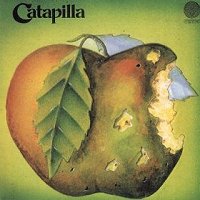 Catapilla released two highly original albums on the legendary Vertigo-"swirl" label. Their style was jazzy, sax-driven progressive rock with lengthy tracks. They really don't remind me of any other band, with the possible exception for "Tumbleweed" and "Promises" that both reminds me a little bit of Affinity (another Vertigo-"swirl" band). The album opens with the 15-minute "Naked Death". It features heavy sax-work, powerful vocal-parts with the aggressive, tormented female vocals of Anna Meek, and a long jam in the middle. What really gave Catapilla their distinctive stamp were probably the vocals of Meek and the atmospheric sax-playing. The highlight on the album is of course the 24-minute "Embryonic Fusion". An intense blowouts of energetic, saxophone-driven early 70's jazz-influenced progressive rock. It features great jamming and some structured and strong riffs too. A good album for anyone who likes saxophone-dominated progressive rock. Catapilla released two highly original albums on the legendary Vertigo-"swirl" label. Their style was jazzy, sax-driven progressive rock with lengthy tracks. They really don't remind me of any other band, with the possible exception for "Tumbleweed" and "Promises" that both reminds me a little bit of Affinity (another Vertigo-"swirl" band). The album opens with the 15-minute "Naked Death". It features heavy sax-work, powerful vocal-parts with the aggressive, tormented female vocals of Anna Meek, and a long jam in the middle. What really gave Catapilla their distinctive stamp were probably the vocals of Meek and the atmospheric sax-playing. The highlight on the album is of course the 24-minute "Embryonic Fusion". An intense blowouts of energetic, saxophone-driven early 70's jazz-influenced progressive rock. It features great jamming and some structured and strong riffs too. A good album for anyone who likes saxophone-dominated progressive rock.
Catapilla - "Changes" (Vertigo 1972)
 The second and last album from Catapilla was even weirder and more experimental than the debut, but actually also better. Robert Calvert delivers some of the best and most beautiful sax-playing I've ever heard on an album. Listen to the instrumental "It Could Only Happen to Me" and you'll hear what I'm talking about. You can hear the same on the last minutes of the 12-minute opener "Reflections" and "Thank Christ for George". The music seems often to be based on jams, and always dominated by Calvert`s saxophone and Meek's voice. Unusual, original, atmospheric and always very beautiful in the more quiet parts. If you're tired of Genesis and Yes clones and want to hear something far more original progressive rock, then you definitively should try Catapilla. The second and last album from Catapilla was even weirder and more experimental than the debut, but actually also better. Robert Calvert delivers some of the best and most beautiful sax-playing I've ever heard on an album. Listen to the instrumental "It Could Only Happen to Me" and you'll hear what I'm talking about. You can hear the same on the last minutes of the 12-minute opener "Reflections" and "Thank Christ for George". The music seems often to be based on jams, and always dominated by Calvert`s saxophone and Meek's voice. Unusual, original, atmospheric and always very beautiful in the more quiet parts. If you're tired of Genesis and Yes clones and want to hear something far more original progressive rock, then you definitively should try Catapilla.
Cathedral - "Stained Glass Stories" (Delta 1978)
 Cathedral's first and only album "Stained Glass Stories" is the definitive American symphonic progressive rock release for many people. It's a very complex album that takes quite some listens to get fully into. Their influences was the traditional stuff (Yes, Genesis and King Crimson) but they were able to create a style and sound of their own, and they were undoubtedly a big inspiration for Änglagĺrd when that band recorded and released their legendary "Hybris"-album 15 years later. The opening track "Introspect" was a 12-minute journey that goes from atmospheric and melodic beauty to distorted and noisy parts. The mellotron was used in a quite original and often disharmonic way. The superb and powerful bass-work of Fred Callan was mixed very much in front of the music, and drummer Mercury Caronia IV contributed with lots of complex and original drumming, using a very large battery. The tasty guitar-playing of Rudy Perrone was clearly inspired by Steve Howe, and you can hear this especially on the instrumental "Gong". The only weak link in the band was singer Paul Seal who sounded like a strained and weaker version of John Wetton. But it's really not much to care about, as the focus of the music is on the instrumental side most of the time. The only exceptions are "The Crossing" and the excellent closing-number "The Search" that features some of the strongest melodies on the album. "Days & Changes" is an amusing demonstration of how many different ways you can play a simple and atmospheric theme. "Stained Glass Stories" was ignored upon its release due to the time and period, but has now got the attention and respect it deserves from progressive rock fans. Cathedral's first and only album "Stained Glass Stories" is the definitive American symphonic progressive rock release for many people. It's a very complex album that takes quite some listens to get fully into. Their influences was the traditional stuff (Yes, Genesis and King Crimson) but they were able to create a style and sound of their own, and they were undoubtedly a big inspiration for Änglagĺrd when that band recorded and released their legendary "Hybris"-album 15 years later. The opening track "Introspect" was a 12-minute journey that goes from atmospheric and melodic beauty to distorted and noisy parts. The mellotron was used in a quite original and often disharmonic way. The superb and powerful bass-work of Fred Callan was mixed very much in front of the music, and drummer Mercury Caronia IV contributed with lots of complex and original drumming, using a very large battery. The tasty guitar-playing of Rudy Perrone was clearly inspired by Steve Howe, and you can hear this especially on the instrumental "Gong". The only weak link in the band was singer Paul Seal who sounded like a strained and weaker version of John Wetton. But it's really not much to care about, as the focus of the music is on the instrumental side most of the time. The only exceptions are "The Crossing" and the excellent closing-number "The Search" that features some of the strongest melodies on the album. "Days & Changes" is an amusing demonstration of how many different ways you can play a simple and atmospheric theme. "Stained Glass Stories" was ignored upon its release due to the time and period, but has now got the attention and respect it deserves from progressive rock fans.
Celeste - "Principe Di Giorno" (Grog 1976)
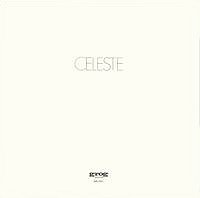 Celeste released a very beautiful and pleasant album that ranks among the best releases from the Italian 70's progressive rock scene. They were a four-piece that consisted of guitar, bass, flute, mellotron and some synths. There is no drums, and the music is always very quiet and atmospheric. "Favole Antiche" is a very representative track. Gracious mellotron, very pleasant vocals, long and beautiful instrumental parts with lot of flute, piano and mellotron. Very atmospheric and relaxed music all the way, and often stunningly beautiful. Some parts, like the vocal part of "Giochi Nella Notte" sounds quite folk-influenced. "La Grande Isola" is another goodie with marvellous mellotron and wonderful themes. This is a very worthwhile listen if you're into Italian 70's progressive rock. Celeste released a very beautiful and pleasant album that ranks among the best releases from the Italian 70's progressive rock scene. They were a four-piece that consisted of guitar, bass, flute, mellotron and some synths. There is no drums, and the music is always very quiet and atmospheric. "Favole Antiche" is a very representative track. Gracious mellotron, very pleasant vocals, long and beautiful instrumental parts with lot of flute, piano and mellotron. Very atmospheric and relaxed music all the way, and often stunningly beautiful. Some parts, like the vocal part of "Giochi Nella Notte" sounds quite folk-influenced. "La Grande Isola" is another goodie with marvellous mellotron and wonderful themes. This is a very worthwhile listen if you're into Italian 70's progressive rock.
Centipede - "Septober Energy" (Neon 1971)
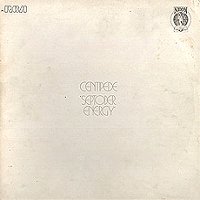 The double-album "Septober Energy" was the only release by Keith Tippett's mammoth-project Centipede. The group consisted of over 50 musicians, and among the best known ones were Robert Wyatt, Ian Carr, Elton Dean, Ian McDonald, Karl Jenkins, Mike Patto, Julie Tippett, Harry Miller, and Robert Fripp produced the whole mess. Musically this is very experimental jazzy progressive rock with tons of horns, strings, various percussions and some passages with vocals. The record could have been an exciting and interesting listen, but ends instead up as four sides of vinyl with nearly completely worthless and self-indulgent exercises in boredom. Side one seems to have absolutely no structure at all, and ranges from noisy improvisations to quiet noodling. Awful and EXTREMELY boring. The second side just had to be better, and it is. It features some nice riffs and lengthy solos on trumpet, sax and guitar over steady rhythms. But it gets rather tiresome after a while, and I've lost my interest in it a long time before the side has reached its end. Side three (there's no track list on this album, so I have to refer to the sides) is an attempt at making contemporary classical music, but ends up as annoying and chaotic noise. The last side is an extended and re-arranged version of "Green and Orange Night Park" from The Keith Tippett's Group's "Dedicated to You, But You Weren't Listening" that was released earlier the same year, and stands probably as the best moment on the album. "Septober Energy" could easily have been trimmed down to a five minute long prog-tune. Rarely have so many musicians used so much time and space to say so little. The double-album "Septober Energy" was the only release by Keith Tippett's mammoth-project Centipede. The group consisted of over 50 musicians, and among the best known ones were Robert Wyatt, Ian Carr, Elton Dean, Ian McDonald, Karl Jenkins, Mike Patto, Julie Tippett, Harry Miller, and Robert Fripp produced the whole mess. Musically this is very experimental jazzy progressive rock with tons of horns, strings, various percussions and some passages with vocals. The record could have been an exciting and interesting listen, but ends instead up as four sides of vinyl with nearly completely worthless and self-indulgent exercises in boredom. Side one seems to have absolutely no structure at all, and ranges from noisy improvisations to quiet noodling. Awful and EXTREMELY boring. The second side just had to be better, and it is. It features some nice riffs and lengthy solos on trumpet, sax and guitar over steady rhythms. But it gets rather tiresome after a while, and I've lost my interest in it a long time before the side has reached its end. Side three (there's no track list on this album, so I have to refer to the sides) is an attempt at making contemporary classical music, but ends up as annoying and chaotic noise. The last side is an extended and re-arranged version of "Green and Orange Night Park" from The Keith Tippett's Group's "Dedicated to You, But You Weren't Listening" that was released earlier the same year, and stands probably as the best moment on the album. "Septober Energy" could easily have been trimmed down to a five minute long prog-tune. Rarely have so many musicians used so much time and space to say so little.
Cervello - "Melos" (Ricordi 1973)
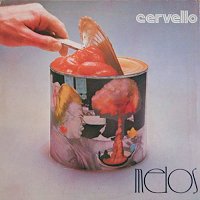 Italian band Cervello included guitarist Corrado Rustici who was the brother of Danilo Rustici from the excellent Osanna. So it may not come as a surprise that their first and only LP was not all that far away from Osanna in style, but perhaps slightly more folk-influenced. "Melos" is supposedly a concept-album based on Greek mythology, and is musically not a very immediate or easy album to get into. It takes some time and several listens to notice the beauty of many melodies on the record. It also has its share of weird riffs and rhythms, although without getting into nonsensical avant-garde territory or pointless experimentation. All the songs on "Melos" are, with the exception of the short closer "Affresco", very complex and progressive. The arrangements features lots of flutes (four of the five members played flute!), vibes and saxophone along with acoustic and electric guitar. No keyboards are listed on the cover, although the deep and sinister sound that can be heard on several tracks certainly sounds much like a very low Mellotron-tone. The opener "Canto del Capro" starts quite loosely and dark with massing, spoken vocals that quickly turns into harmonies of a much more joyful and lighter kind before the track goes into a heavy and bluesy but still quite weird riff with distorted vocals on top. It's quite striking when the flutes take over the riff, and the track slowly fades out. "Trittico" features some of the finest melodies of the record, and the recorder gives a slight medieval-feel to the opening of "Euterpe". "Scinsicne (T.R.M.)" has a really gloomy instrumental passage with some distorted sounds that is quite hard to figure out what really is, considering that the band claimed to use no keyboards. The saxophone on the title-track is not all that far from the sound of Citta Frontale, another Italian band in a similar vein. And the dramatic "Galassia" turns into a sax-driven cacophony based in a disharmonic riff at the end. "Melos" is intriguing and uniquely Italian progressive rock worth hearing if you're into this particular style. Italian band Cervello included guitarist Corrado Rustici who was the brother of Danilo Rustici from the excellent Osanna. So it may not come as a surprise that their first and only LP was not all that far away from Osanna in style, but perhaps slightly more folk-influenced. "Melos" is supposedly a concept-album based on Greek mythology, and is musically not a very immediate or easy album to get into. It takes some time and several listens to notice the beauty of many melodies on the record. It also has its share of weird riffs and rhythms, although without getting into nonsensical avant-garde territory or pointless experimentation. All the songs on "Melos" are, with the exception of the short closer "Affresco", very complex and progressive. The arrangements features lots of flutes (four of the five members played flute!), vibes and saxophone along with acoustic and electric guitar. No keyboards are listed on the cover, although the deep and sinister sound that can be heard on several tracks certainly sounds much like a very low Mellotron-tone. The opener "Canto del Capro" starts quite loosely and dark with massing, spoken vocals that quickly turns into harmonies of a much more joyful and lighter kind before the track goes into a heavy and bluesy but still quite weird riff with distorted vocals on top. It's quite striking when the flutes take over the riff, and the track slowly fades out. "Trittico" features some of the finest melodies of the record, and the recorder gives a slight medieval-feel to the opening of "Euterpe". "Scinsicne (T.R.M.)" has a really gloomy instrumental passage with some distorted sounds that is quite hard to figure out what really is, considering that the band claimed to use no keyboards. The saxophone on the title-track is not all that far from the sound of Citta Frontale, another Italian band in a similar vein. And the dramatic "Galassia" turns into a sax-driven cacophony based in a disharmonic riff at the end. "Melos" is intriguing and uniquely Italian progressive rock worth hearing if you're into this particular style.
Cherry Five - "Cherry Five" (Cinevox 1974)
 This pre-Goblin outfit released a self-titled album in 1974 that should have great appeal to everyone who loves the typical 70's sound. The music here is ballsy symphonic progressive rock of a more traditional kind than the horror-soundtracks that they later would make as Goblin. The lyrics are unlike most other Italian progressive rock bands sung in English and it works very well. The opener "Country Graveyard" is very representative for the album. Tight, energetic and complex progressive rock based in strong themes and arrangements with lots of mellotron, organ, 70's synths and guitar. Some of the breaks in "The Picture of Dorian Gray" sounds a bit like Genesis, and the organ on "Oliver" have an obvious ELP-influence. The two-part "The Swan is a Murderer" also made some very intelligent use of harpsichord. This is a very strong album, and next to PFM's "Photos of Ghosts" it will probably be one of the easiest and best places to start if you're not familiar with Italian progressive rock yet. This pre-Goblin outfit released a self-titled album in 1974 that should have great appeal to everyone who loves the typical 70's sound. The music here is ballsy symphonic progressive rock of a more traditional kind than the horror-soundtracks that they later would make as Goblin. The lyrics are unlike most other Italian progressive rock bands sung in English and it works very well. The opener "Country Graveyard" is very representative for the album. Tight, energetic and complex progressive rock based in strong themes and arrangements with lots of mellotron, organ, 70's synths and guitar. Some of the breaks in "The Picture of Dorian Gray" sounds a bit like Genesis, and the organ on "Oliver" have an obvious ELP-influence. The two-part "The Swan is a Murderer" also made some very intelligent use of harpsichord. This is a very strong album, and next to PFM's "Photos of Ghosts" it will probably be one of the easiest and best places to start if you're not familiar with Italian progressive rock yet.
Circus - "Circus" (Transatlantic 1969)
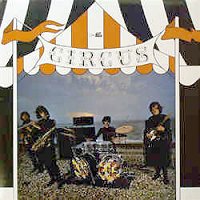 Circus was one of the first bands to feature the talents of the well-known flutist and sax-player Mel Collins. Their self-titled debut was their only album, and consisted mostly of cover-material, but also a couple of tunes written by Collins. Musically this is typical early progressive rock that varies between the heavy, jazzy and psychedelic. Their heavy side is showed best through their really raw adaptation of The Beatles' "Norwegian Wood" that opens the album. Two other of the other cover-tunes, Charles Mingus' "Il B.S." and the traditional tune "St. Thomas", demonstrated the jazz-influenced side of the band. Tim Hardin's "Don't Make Promises" had been turned into a typical flute-driven progressive rock track with an instrumental break in the middle. The same goes for Mama and the Papas' "Monday, Monday". But my personal favourite is the airy and atmospheric progressive ballad "Pleasures of a Lifetime" that was penned by Collins himself. His two other songs, the short instrumental "Goodnight John Morgan" and the psychedelic "Father of My Daughter" were less impressive, but still listenable enough. Despite the wide use of cover-material, this is a good and solid album that will appeal to fans of flute/sax-driven progressive rock. Circus was one of the first bands to feature the talents of the well-known flutist and sax-player Mel Collins. Their self-titled debut was their only album, and consisted mostly of cover-material, but also a couple of tunes written by Collins. Musically this is typical early progressive rock that varies between the heavy, jazzy and psychedelic. Their heavy side is showed best through their really raw adaptation of The Beatles' "Norwegian Wood" that opens the album. Two other of the other cover-tunes, Charles Mingus' "Il B.S." and the traditional tune "St. Thomas", demonstrated the jazz-influenced side of the band. Tim Hardin's "Don't Make Promises" had been turned into a typical flute-driven progressive rock track with an instrumental break in the middle. The same goes for Mama and the Papas' "Monday, Monday". But my personal favourite is the airy and atmospheric progressive ballad "Pleasures of a Lifetime" that was penned by Collins himself. His two other songs, the short instrumental "Goodnight John Morgan" and the psychedelic "Father of My Daughter" were less impressive, but still listenable enough. Despite the wide use of cover-material, this is a good and solid album that will appeal to fans of flute/sax-driven progressive rock.
Circus - "Movin' On" (Zyt 1977)
 "Movin' On" is a quite interesting and original release from this Swiss band (that has absolutely nothing to do with the British band reviewed above). Their music is not easy to describe, as they actually doesn't remind me much of any other band. The songs on side 1 are complex, atmospheric and intriguing pieces with lots of tasty flute, guitar and often emotional and beautiful vocals. Some vibes and saxophone is also used, giving the music a slight jazzy edge from time to time. Some minor folk-influences can also be heard. The instrumental "Dawn" builds up from a quiet and experimental part before it reaches the climax with a powerful bass-riff. Side 2 consists of the 22-minute title-track that is far more energetic than anything on the first side. The performance is very tight and impressive, and you'll especially notice the bass-player, but the whole band consisted clearly of great musicians. The track also includes some surprisingly Yes-like harmonies, but the rest of the vocal sections of the track were done in Circus' own style. Good and recommended stuff. "Movin' On" is a quite interesting and original release from this Swiss band (that has absolutely nothing to do with the British band reviewed above). Their music is not easy to describe, as they actually doesn't remind me much of any other band. The songs on side 1 are complex, atmospheric and intriguing pieces with lots of tasty flute, guitar and often emotional and beautiful vocals. Some vibes and saxophone is also used, giving the music a slight jazzy edge from time to time. Some minor folk-influences can also be heard. The instrumental "Dawn" builds up from a quiet and experimental part before it reaches the climax with a powerful bass-riff. Side 2 consists of the 22-minute title-track that is far more energetic than anything on the first side. The performance is very tight and impressive, and you'll especially notice the bass-player, but the whole band consisted clearly of great musicians. The track also includes some surprisingly Yes-like harmonies, but the rest of the vocal sections of the track were done in Circus' own style. Good and recommended stuff.
Citta' Frontale - "El Tor" (Fonit 1975)
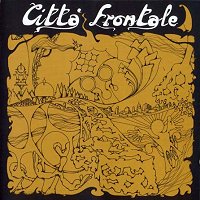 This band included some former members of Osanna, and that's not too hard to hear. "El Tor" is a album that often sounds like a more polished and less complex version of the Osanna sound. The sound is dominated by flute, saxophone and some mellotron. The best track here is "Duro Lavoro". A great progressive rock track with lots of great themes. "Solo Uniti..." is a quite up-tempo track, while the title-track and the opening instrumental "Alba Di Una Citta'" are more relaxed pieces. "La Casa Del Mercante "Sun"" sounds a little bit folkish. The music is quite vocal- orientated and very structured. The band's sound together with good songwriting makes this a nice and pleasant album. This band included some former members of Osanna, and that's not too hard to hear. "El Tor" is a album that often sounds like a more polished and less complex version of the Osanna sound. The sound is dominated by flute, saxophone and some mellotron. The best track here is "Duro Lavoro". A great progressive rock track with lots of great themes. "Solo Uniti..." is a quite up-tempo track, while the title-track and the opening instrumental "Alba Di Una Citta'" are more relaxed pieces. "La Casa Del Mercante "Sun"" sounds a little bit folkish. The music is quite vocal- orientated and very structured. The band's sound together with good songwriting makes this a nice and pleasant album.
Clearlight - "Symphony" (Virgin 1975)
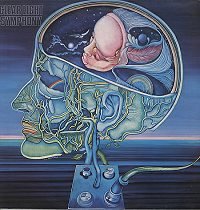 French composer and keyboardist Cyrille Verdeaux gained lots of deserved respect and recognition in the progressive rock community with his project Clearlight. The band never seemed to have any other permanent members than himself, preferring to instead hire in a bunch of highly competent guest musicians for each album. For the debut "Symphony" he got several members from Gong to help him record and perform the 40-minute instrumental symphonic progressive space rock suite he had composed for the album, including Steve Hillage, Tim Blake and Didier Malherbe. Their presence was luckily enough not infested with the madness of Daevid Allen, and they played Verdeaux' masterpiece as tight and technically perfect as it possibly could be. But the true star is of course Mr. Verdeaux himself, layering the whole piece with tons of piano, Mellotron, synths and spacey organ. The piece opens with the main-theme, an immediate piano-melody that will resurface through the entire suite to tie it well together. A part that can be both chaotic and hypnotic at the same time follows it, introducing a certain spacey touch to the music. The piece then calms down to a part that slowly builds up in intensity, and dominated by an organ that reminds me of Bo Hansson of all things. One of Verdeaux' trademark energetic piano-riffs then kicks in an leads into the most intense and energetic part of the album, a jam where all the musicians really let go of all brakes. It ends in a cacophony where some jazzy free-form piano returns the piece to the main theme again. The part that follows is no less than fantastic, featuring a Mellotron that slowly starts to creep around Verdeaux' underpinning rhythmic piano before the rest of the musicians kick in, making the musical orgasm complete. The first part then ends with the main-theme again, before a spacey and dreamy synth slowly fades out. The second side is less energetic with almost no drums, and is based more around atmospheric symphonic/spacey themes dominated by Mellotron and synths. Many of these are really beautiful, especially one toward the end where Verdeaux uses the Mellotron-cello to great effect, with grandiose guitar-fanfares stuck in between. The very end of the piece goes almost into electronic progressive territory, before those now well-familiar piano-chords make a final appearance, now surrounded by Mellotron-choir and the whole suite fades out with a really piercing and high-frequency spacey sound. "Symphony" is probably the highlight of Clearlight's career, naturally making it the first record you should get of theirs. French composer and keyboardist Cyrille Verdeaux gained lots of deserved respect and recognition in the progressive rock community with his project Clearlight. The band never seemed to have any other permanent members than himself, preferring to instead hire in a bunch of highly competent guest musicians for each album. For the debut "Symphony" he got several members from Gong to help him record and perform the 40-minute instrumental symphonic progressive space rock suite he had composed for the album, including Steve Hillage, Tim Blake and Didier Malherbe. Their presence was luckily enough not infested with the madness of Daevid Allen, and they played Verdeaux' masterpiece as tight and technically perfect as it possibly could be. But the true star is of course Mr. Verdeaux himself, layering the whole piece with tons of piano, Mellotron, synths and spacey organ. The piece opens with the main-theme, an immediate piano-melody that will resurface through the entire suite to tie it well together. A part that can be both chaotic and hypnotic at the same time follows it, introducing a certain spacey touch to the music. The piece then calms down to a part that slowly builds up in intensity, and dominated by an organ that reminds me of Bo Hansson of all things. One of Verdeaux' trademark energetic piano-riffs then kicks in an leads into the most intense and energetic part of the album, a jam where all the musicians really let go of all brakes. It ends in a cacophony where some jazzy free-form piano returns the piece to the main theme again. The part that follows is no less than fantastic, featuring a Mellotron that slowly starts to creep around Verdeaux' underpinning rhythmic piano before the rest of the musicians kick in, making the musical orgasm complete. The first part then ends with the main-theme again, before a spacey and dreamy synth slowly fades out. The second side is less energetic with almost no drums, and is based more around atmospheric symphonic/spacey themes dominated by Mellotron and synths. Many of these are really beautiful, especially one toward the end where Verdeaux uses the Mellotron-cello to great effect, with grandiose guitar-fanfares stuck in between. The very end of the piece goes almost into electronic progressive territory, before those now well-familiar piano-chords make a final appearance, now surrounded by Mellotron-choir and the whole suite fades out with a really piercing and high-frequency spacey sound. "Symphony" is probably the highlight of Clearlight's career, naturally making it the first record you should get of theirs.
Clearlight - "Forever Blowing Bubbles" (Virgin 1976)
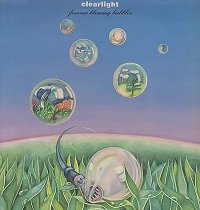 The second album from Verdeaux' band differed from "Symphony" by the fact that it was divided into shorter tracks, and also featured vocals on a couple of them. The line-up on "Forever Blowing Bubbles" seemed to be an almost completely French one, although well-known violinist David Cross also was featured on some passages. Verdeaux also allowed bassist and vocalist Joel Dugrenot to contribute with two compositions of his own. His dynamic opener "Chanson" is one of the best on the record, varying between his laid-back and dreamy French vocals and powerful instrumental segments. The other track he wrote, "Way", featured vocals in the same style, but the rest of the song was more typical Clearlight, including a typical distinctive piano-riff from Verdeaux. The most surprising song on the record was however "Narcisse et Goldmund", a short medieval-styled ballad complete with piano, flute violin, classical guitar and Brigitte Roy's vocals. The rest of the album was pretty much in the style of "Symphony", although perhaps slightly jazzier. "Without Words", "Ergotrip" and the highlight "Et Pendant Ce Temps La" are all good, spacey symphonic jams based loosely around themes played on piano and Mellotron in the typical Clearlight style with lots of underlying spacey synths. The only element that is close to giving the album a unifying conceptual feel was the "bubbles-synth" (actually an ARP 2600) of Francois Jeanneau that frequently pops up in between songs and finally makes their most prominent appearance in the really weird closer "Jungle Bubbles". "Forever Blowing Bubbles" was another strong album from Verdeaux & co. who proved that he could maintain the signature sound of his group without stagnate or repeating himself. The second album from Verdeaux' band differed from "Symphony" by the fact that it was divided into shorter tracks, and also featured vocals on a couple of them. The line-up on "Forever Blowing Bubbles" seemed to be an almost completely French one, although well-known violinist David Cross also was featured on some passages. Verdeaux also allowed bassist and vocalist Joel Dugrenot to contribute with two compositions of his own. His dynamic opener "Chanson" is one of the best on the record, varying between his laid-back and dreamy French vocals and powerful instrumental segments. The other track he wrote, "Way", featured vocals in the same style, but the rest of the song was more typical Clearlight, including a typical distinctive piano-riff from Verdeaux. The most surprising song on the record was however "Narcisse et Goldmund", a short medieval-styled ballad complete with piano, flute violin, classical guitar and Brigitte Roy's vocals. The rest of the album was pretty much in the style of "Symphony", although perhaps slightly jazzier. "Without Words", "Ergotrip" and the highlight "Et Pendant Ce Temps La" are all good, spacey symphonic jams based loosely around themes played on piano and Mellotron in the typical Clearlight style with lots of underlying spacey synths. The only element that is close to giving the album a unifying conceptual feel was the "bubbles-synth" (actually an ARP 2600) of Francois Jeanneau that frequently pops up in between songs and finally makes their most prominent appearance in the really weird closer "Jungle Bubbles". "Forever Blowing Bubbles" was another strong album from Verdeaux & co. who proved that he could maintain the signature sound of his group without stagnate or repeating himself.
CMU - "Open Spaces" (Transatlantic 1971)
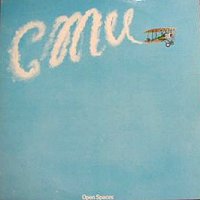 CMU stands for Contemporary Music Unit (no less), and were one of the few progressive rock bands to feature both male and female vocals. With influences mainly from psych and blues, their debut "Open Spaces" occasionally reminds a bit of Affinity, especially on the passages sung by Larraine Odell. The opener "Henry" is one of the better tracks, based in a nice melody and with tasteful, atmospheric arrangements consisting of piano, guitar, bass, drums and some almost inaudible flute. "Voodoo Man" sounds like something Arthur Brown could have done, and the heavy chorus in the middle introduces the raspy voice of James Gordon, who together with guitarist Ian Hamlett is the main reason for the bluesy touch of this album. Hamlett really proves that point on the instrumental "Slow and Lonesome Blues" that is actually a bit faster and more energetic than what you would expect from such a title. "Chantecleer" starts slow, dark and moody with some haunting pairing of vocals from Odell and Gordon, but builds quickly up to a fast, organ-driven and almost funky tune where an influence from Arthur Brown again can be detected. The second side opens with "Japan", an attempt at traditional Japanese folk music that sounds surprisingly authentic, especially when considering that the band just used their usual instruments. "Clown" is a lightweight and whimsical tune, but catchy enough to be worthwhile, and Gordon's vocals has an unusual operatic twist here. One of the most best melodies on the record can be found in "Mystical Sounds", a ballad dominated by Hamlet's flute and Odell's voice. The title-track is a lengthy, mystical and atmospheric journey with lots of dreamy, wordless vocals from the two singers, and keyboardist Terry Mortimer also contributes with some spooky violin here. A listenable record of psych and blues with progressive overtones, but nothing really special. CMU stands for Contemporary Music Unit (no less), and were one of the few progressive rock bands to feature both male and female vocals. With influences mainly from psych and blues, their debut "Open Spaces" occasionally reminds a bit of Affinity, especially on the passages sung by Larraine Odell. The opener "Henry" is one of the better tracks, based in a nice melody and with tasteful, atmospheric arrangements consisting of piano, guitar, bass, drums and some almost inaudible flute. "Voodoo Man" sounds like something Arthur Brown could have done, and the heavy chorus in the middle introduces the raspy voice of James Gordon, who together with guitarist Ian Hamlett is the main reason for the bluesy touch of this album. Hamlett really proves that point on the instrumental "Slow and Lonesome Blues" that is actually a bit faster and more energetic than what you would expect from such a title. "Chantecleer" starts slow, dark and moody with some haunting pairing of vocals from Odell and Gordon, but builds quickly up to a fast, organ-driven and almost funky tune where an influence from Arthur Brown again can be detected. The second side opens with "Japan", an attempt at traditional Japanese folk music that sounds surprisingly authentic, especially when considering that the band just used their usual instruments. "Clown" is a lightweight and whimsical tune, but catchy enough to be worthwhile, and Gordon's vocals has an unusual operatic twist here. One of the most best melodies on the record can be found in "Mystical Sounds", a ballad dominated by Hamlet's flute and Odell's voice. The title-track is a lengthy, mystical and atmospheric journey with lots of dreamy, wordless vocals from the two singers, and keyboardist Terry Mortimer also contributes with some spooky violin here. A listenable record of psych and blues with progressive overtones, but nothing really special.
CMU - "Space Cabaret" (Transatlantic 1973)
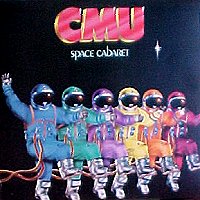 Only the Odell-couple and Ian Hamlett remained from the first album. Mortimer, Gordon and bassist Ed Lee had been replaced by Richard Joseph on vocals and acoustic guitar, Steve Cook on bass and finally Leary Hasson on keyboards. The latter one had earlier played in Marsupilami, and was undoubtedly the most exciting of the new members. "Space Cabaret" is musically quite different from the debut. The bluesy tendencies were gone, and the band went instead for a more symphonic and spacey kind of progressive rock with some slight folk-influences and overall far more complex material. The lyrics were also considerably more far out and dreamy than on the debut, fitting well to the new musical direction. The 17-minute title-track in four parts is probably the best thing the band ever did. Hasson introduced Mellotron, el-piano and some spacey synths to the band's sound, and Joseph are allowed to sing a lot more along with Odell than what Gordon ever was on the debut. The melodies are thoroughly strong and the arrangements have a spacey sweep and atmosphere to them. The first side closes with the short and acoustic "Doctor Am I Normal?". This charming folk-song seems to be a bit out of place from the rest of the record's space-concept, but is still a good tune. The second side is taken up by two complex 10-minute pieces. First out is "Dream" that starts slow and gloomy, but quickly picks up the pace in the funky mid-part that finally leads out into a quite heavy finale. The closer "Light Shine" is, despite several vocal-passages, mostly a showcase for Hasson and his various sounds, climaxing in a fine jam between his organ and Hamlett's guitar. "Space Cabaret" is easily the best of CMU's two albums. Only the Odell-couple and Ian Hamlett remained from the first album. Mortimer, Gordon and bassist Ed Lee had been replaced by Richard Joseph on vocals and acoustic guitar, Steve Cook on bass and finally Leary Hasson on keyboards. The latter one had earlier played in Marsupilami, and was undoubtedly the most exciting of the new members. "Space Cabaret" is musically quite different from the debut. The bluesy tendencies were gone, and the band went instead for a more symphonic and spacey kind of progressive rock with some slight folk-influences and overall far more complex material. The lyrics were also considerably more far out and dreamy than on the debut, fitting well to the new musical direction. The 17-minute title-track in four parts is probably the best thing the band ever did. Hasson introduced Mellotron, el-piano and some spacey synths to the band's sound, and Joseph are allowed to sing a lot more along with Odell than what Gordon ever was on the debut. The melodies are thoroughly strong and the arrangements have a spacey sweep and atmosphere to them. The first side closes with the short and acoustic "Doctor Am I Normal?". This charming folk-song seems to be a bit out of place from the rest of the record's space-concept, but is still a good tune. The second side is taken up by two complex 10-minute pieces. First out is "Dream" that starts slow and gloomy, but quickly picks up the pace in the funky mid-part that finally leads out into a quite heavy finale. The closer "Light Shine" is, despite several vocal-passages, mostly a showcase for Hasson and his various sounds, climaxing in a fine jam between his organ and Hamlett's guitar. "Space Cabaret" is easily the best of CMU's two albums.
Colosseum - "Valentyne Suite" (Vertigo 1969)
 Colosseum was the bluesy early jazz-rock band where Dave Greenslade played before he formed his far more progressive main project named after himself. Colosseum were on the other hand only marginally interesting from a progressive point of view, but with one striking exception: their second album "Valentyne Suite". It was not only the very first record to be released on Philips' legendary progressive label Vertigo, but it also featured one of the very best progressive pieces of the late 60's in form of the side-long title-track composed by Greenslade. This was an intense firework of hyper-energetic and jazz-inflected early progressive rock dominated by great themes and some truly breathtaking organ-solos from Greenslade built around the sax-riffs of Dick Heckstall-Smith, all driven forward by some really furious drum-work from Jon Hiseman. Some classical influences can actually also be heard during the short bridge in the middle that ties together the two main parts of the track. "Valentyne Suite" blows me away every time I hear it. The first and less progressive side of the album features four songs that vary quite much stylistically. The opener "The Kettle" surprises quite a bit with its very punchy hard rock, while "The Machine Demands a Sacrifice" could have been taken from Jethro Tull's very first album. "Butty's Blues" is a ballsy and somewhat progressive blues. But the true highlight among the shorter tracks is "Elegy", a jazzy and irresistibly strolling song. "Valentyne Suite" is the only album you'll really need with Colosseum, and you can safely move forward to Greenslade's own group after you've bought it. Colosseum was the bluesy early jazz-rock band where Dave Greenslade played before he formed his far more progressive main project named after himself. Colosseum were on the other hand only marginally interesting from a progressive point of view, but with one striking exception: their second album "Valentyne Suite". It was not only the very first record to be released on Philips' legendary progressive label Vertigo, but it also featured one of the very best progressive pieces of the late 60's in form of the side-long title-track composed by Greenslade. This was an intense firework of hyper-energetic and jazz-inflected early progressive rock dominated by great themes and some truly breathtaking organ-solos from Greenslade built around the sax-riffs of Dick Heckstall-Smith, all driven forward by some really furious drum-work from Jon Hiseman. Some classical influences can actually also be heard during the short bridge in the middle that ties together the two main parts of the track. "Valentyne Suite" blows me away every time I hear it. The first and less progressive side of the album features four songs that vary quite much stylistically. The opener "The Kettle" surprises quite a bit with its very punchy hard rock, while "The Machine Demands a Sacrifice" could have been taken from Jethro Tull's very first album. "Butty's Blues" is a ballsy and somewhat progressive blues. But the true highlight among the shorter tracks is "Elegy", a jazzy and irresistibly strolling song. "Valentyne Suite" is the only album you'll really need with Colosseum, and you can safely move forward to Greenslade's own group after you've bought it.
Label
Cornucopia - "Full Horn" (Brain 1973)
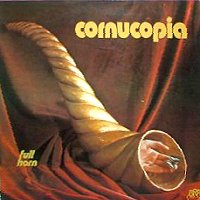 A very complex and weird one-shot from Germany. Actually, when it comes to complexity, rawness and disharmonious elements, these guys tends to remind me of Il Balletto di Bronzo's "Ys". Of course, "Full Horn" didn't have the same fantastic atmosphere and is never close to equal the Italian masterpiece but it's still a decent, interesting and unique progressive rock album. The 20-minute suite "Day of a Daydream Believer" takes up the first side. The composition never stays the same and shifts from raw and disharmonious parts to softer and more atmospheric passages, often dominated by a spacey organ and vocal-harmonies. The arrangements include lots of organ, thundering bass & guitar work, energetic drumming and also some flute & saxophone. Possibly one of the weirdest and most complex tracks to ever come from the German progressive rock scene. Side 2 starts with a rather poppy and light tune, but we're taken back to the style of the first side again with the 12-minute "Spot on You, Kids". A few passages on the album (like the two first minutes on the closing track "And the Madness...") seems to be weird only for the weirdness' sake, but most of it is an enjoyable and challenging listen. A very complex and weird one-shot from Germany. Actually, when it comes to complexity, rawness and disharmonious elements, these guys tends to remind me of Il Balletto di Bronzo's "Ys". Of course, "Full Horn" didn't have the same fantastic atmosphere and is never close to equal the Italian masterpiece but it's still a decent, interesting and unique progressive rock album. The 20-minute suite "Day of a Daydream Believer" takes up the first side. The composition never stays the same and shifts from raw and disharmonious parts to softer and more atmospheric passages, often dominated by a spacey organ and vocal-harmonies. The arrangements include lots of organ, thundering bass & guitar work, energetic drumming and also some flute & saxophone. Possibly one of the weirdest and most complex tracks to ever come from the German progressive rock scene. Side 2 starts with a rather poppy and light tune, but we're taken back to the style of the first side again with the 12-minute "Spot on You, Kids". A few passages on the album (like the two first minutes on the closing track "And the Madness...") seems to be weird only for the weirdness' sake, but most of it is an enjoyable and challenging listen.
Corte Dei Miracoli - "Corte Dei Miracoli" (Grog 1976)
 One of the Italian classics from the second half of the 70's. Very keyboard dominated, but with a sound of their own. It's almost nothing that will remind you of ELP or stuff like that here. The band used a great amount of different sounding keyboards to very good effect. The songwriting is great all through the whole album. The opening track "...E Verra L'Uomo" has some wonderful and melodic vocal parts relived by a energetic and Hammond dominated instrumental part in the middle. On "Verso Il Sole" the band combines the typical Italian progressive rock sound with an almost Latin influence. The piano solo in the middle sounds quite awesome! "Il Rituale Notturno" is symphonic progressive of a kind any lover of Italian progressive will like. Excellent album. One of the Italian classics from the second half of the 70's. Very keyboard dominated, but with a sound of their own. It's almost nothing that will remind you of ELP or stuff like that here. The band used a great amount of different sounding keyboards to very good effect. The songwriting is great all through the whole album. The opening track "...E Verra L'Uomo" has some wonderful and melodic vocal parts relived by a energetic and Hammond dominated instrumental part in the middle. On "Verso Il Sole" the band combines the typical Italian progressive rock sound with an almost Latin influence. The piano solo in the middle sounds quite awesome! "Il Rituale Notturno" is symphonic progressive of a kind any lover of Italian progressive will like. Excellent album.
Coto-En-Pel - "Holocaust" (Nevada 1978)
 Spanish progressive with a quite strong King Crimson influence. The musicians sounds good and skilled, but their songwriting is unfortunately not of the same class. Every of the lengthy tracks on the album has good tendencies and ideas, but they sounds unfinished and immature. Just listen to tracks like "Aura De Sons" and the first part of the title-track. Both of them has their moments, but the band wastes too much time on passages which goes absolutely nowhere. It sounds that "Holocaust" was released before the songs were finished. It's simply a bunch of ideas that could have been turned into good tracks. As I said, the band's sound is a lot in the Crimson vein (especially the guitarist reminds a lot of Robert Fripp), but it doesn't help when the band obviously didn't know how to develop their ideas into good songs. Spanish progressive with a quite strong King Crimson influence. The musicians sounds good and skilled, but their songwriting is unfortunately not of the same class. Every of the lengthy tracks on the album has good tendencies and ideas, but they sounds unfinished and immature. Just listen to tracks like "Aura De Sons" and the first part of the title-track. Both of them has their moments, but the band wastes too much time on passages which goes absolutely nowhere. It sounds that "Holocaust" was released before the songs were finished. It's simply a bunch of ideas that could have been turned into good tracks. As I said, the band's sound is a lot in the Crimson vein (especially the guitarist reminds a lot of Robert Fripp), but it doesn't help when the band obviously didn't know how to develop their ideas into good songs.
Crack - "Si Todo Hiciera" (Chapa 1979)
 This is perhaps the best Spanish progressive rock band I've heard so far. The album is symphonic progressive at its most tasteful and beautiful. The arrangements are loaded with all the right stuff: mellotron, flute, organ, moog, harpsichord and piano. The compositions sounds incredible beautiful, mellow and melancholic. The opening instrumental "Descenso En El Mahellstrong" and "Amantes De La Irrealidad" gives me goosebumps every time. "Amantes..." starts with a wonderful vocal part which soon turns into a complex and very symphonic instrumental part with lots of mellotron and flute. When the vocalist at the end returns to the main theme, but now with just wordless vocal harmony, its simply so beautiful you could cry. The awesome flute/mellotron intro to "Marchando Una Del Sid" sounds in my ears very typical for Spanish progressive at its very best. You'll also notice some unusually wonderful synth-sounds on a track like "Cobarde O Desertor". If you like bands like Genesis and PFM, then you'll adore this album! This is perhaps the best Spanish progressive rock band I've heard so far. The album is symphonic progressive at its most tasteful and beautiful. The arrangements are loaded with all the right stuff: mellotron, flute, organ, moog, harpsichord and piano. The compositions sounds incredible beautiful, mellow and melancholic. The opening instrumental "Descenso En El Mahellstrong" and "Amantes De La Irrealidad" gives me goosebumps every time. "Amantes..." starts with a wonderful vocal part which soon turns into a complex and very symphonic instrumental part with lots of mellotron and flute. When the vocalist at the end returns to the main theme, but now with just wordless vocal harmony, its simply so beautiful you could cry. The awesome flute/mellotron intro to "Marchando Una Del Sid" sounds in my ears very typical for Spanish progressive at its very best. You'll also notice some unusually wonderful synth-sounds on a track like "Cobarde O Desertor". If you like bands like Genesis and PFM, then you'll adore this album!
Cressida - "Cressida" (Vertigo 1970)
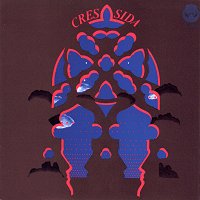 Excellent band in the light and not so very complex Early-British progressive rock style of Beggar's Opera, Cirkus and Spring. They released two classic albums and, next to Spring, Cressida was probably the best example of this style. Their sound is mostly dominated by the most beautiful and atmospheric Hammond-organ sound you can imagine. There's of course also some mellotron here, but it's much less dominant than the organ. And the vocalist reminds me quite a lot of Richard Sinclair. Most of the 12(!) songs on the album are great, but I must especially mention tracks like "Cressida", "Home and Where I Long to Be", "One of a Group" and "To Play Your Little Game". All these beautiful tracks prove that progressive rock doesn't necessarily have to be complex and challenging to be very enjoyable. But a track like "Depression" showed that the group could handle time-changes and excellent solo-parts very well too. Overall, this is a wonderful album and one of my personal favourites of Early-British progressive rock. And it surpasses most other bands of this style, like Cirkus, Moody Blues and Barclay James Harvest. Excellent band in the light and not so very complex Early-British progressive rock style of Beggar's Opera, Cirkus and Spring. They released two classic albums and, next to Spring, Cressida was probably the best example of this style. Their sound is mostly dominated by the most beautiful and atmospheric Hammond-organ sound you can imagine. There's of course also some mellotron here, but it's much less dominant than the organ. And the vocalist reminds me quite a lot of Richard Sinclair. Most of the 12(!) songs on the album are great, but I must especially mention tracks like "Cressida", "Home and Where I Long to Be", "One of a Group" and "To Play Your Little Game". All these beautiful tracks prove that progressive rock doesn't necessarily have to be complex and challenging to be very enjoyable. But a track like "Depression" showed that the group could handle time-changes and excellent solo-parts very well too. Overall, this is a wonderful album and one of my personal favourites of Early-British progressive rock. And it surpasses most other bands of this style, like Cirkus, Moody Blues and Barclay James Harvest.
Cressida - "Asylum" (Vertigo 1971)
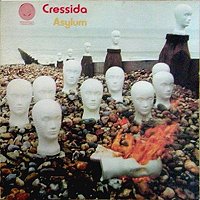 Another masterpiece, but unfortunately their last album. "Asylum" is dominated by longer and a little bit more complex tracks than the debut-album. On some tracks you can also hear some very tasteful and intelligent orchestration. Overall, the album gives more room for instrumental parts, but the excellent and melodious vocal parts still dominates the music. The title-track, "Munich" and "Lisa" are all classic tracks of progressive rock with beautiful melodies, excellent instrumental parts and arrangements so perfectly 70's as it can get. What more can you ask for? Both "Asylum" and the debut-album are essential for any lover of melody based, 70's progressive rock. And Cressida was with no doubt one of the best bands on the legendary Vertigo-swirl label. Another masterpiece, but unfortunately their last album. "Asylum" is dominated by longer and a little bit more complex tracks than the debut-album. On some tracks you can also hear some very tasteful and intelligent orchestration. Overall, the album gives more room for instrumental parts, but the excellent and melodious vocal parts still dominates the music. The title-track, "Munich" and "Lisa" are all classic tracks of progressive rock with beautiful melodies, excellent instrumental parts and arrangements so perfectly 70's as it can get. What more can you ask for? Both "Asylum" and the debut-album are essential for any lover of melody based, 70's progressive rock. And Cressida was with no doubt one of the best bands on the legendary Vertigo-swirl label.
Crucis - "Crucis" (RCA 1975)
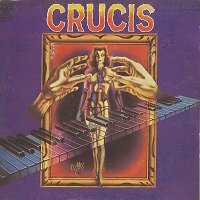 Crucis were one of the best known progressive rock groups from Argentina, and that's not just because they were one of the few on a major label. Musically they had what it takes to be a good progressive rock group, and that's a lot. Their self-titled debut from 1975 consists of complex yet accessible progressive rock with a slight rough edge here and there. The opener "Todo Tiempo Posible" is quite representative for the style of this album, starting as a song-based tune built around a killer organ riff, before exploding into a very tight and impressive complex instrumental section toward the end. The instrumental "Mes" maintains this degree of complexity, as well as showing the band's ear for good melodies and riffs. "Corto Amanecer" and the hard rocking "Irónico Ser" are probably the least interesting songs on the album, but still with enough progressive twists to make them worthwhile. The keyboards on "La Triste Visión del Entierro Propio" toy with some baroque and classical tendencies during the instrumental passages, and these influences are brought even further into the light on the excellent "Recluso Artista". "Determinados Espejos" is yet another pure instrumental number, but with more focus on jamming and a slightly jazzier approach. This style would be perfected on their second and last album, which in my opinion also was their best. But "Crucis" is still an impressive debut, and the band is probably one of the first you should start with if you want to explore the South American progressive rock scene of the '70s, as their style will appeal to most progressive rock fans. Crucis were one of the best known progressive rock groups from Argentina, and that's not just because they were one of the few on a major label. Musically they had what it takes to be a good progressive rock group, and that's a lot. Their self-titled debut from 1975 consists of complex yet accessible progressive rock with a slight rough edge here and there. The opener "Todo Tiempo Posible" is quite representative for the style of this album, starting as a song-based tune built around a killer organ riff, before exploding into a very tight and impressive complex instrumental section toward the end. The instrumental "Mes" maintains this degree of complexity, as well as showing the band's ear for good melodies and riffs. "Corto Amanecer" and the hard rocking "Irónico Ser" are probably the least interesting songs on the album, but still with enough progressive twists to make them worthwhile. The keyboards on "La Triste Visión del Entierro Propio" toy with some baroque and classical tendencies during the instrumental passages, and these influences are brought even further into the light on the excellent "Recluso Artista". "Determinados Espejos" is yet another pure instrumental number, but with more focus on jamming and a slightly jazzier approach. This style would be perfected on their second and last album, which in my opinion also was their best. But "Crucis" is still an impressive debut, and the band is probably one of the first you should start with if you want to explore the South American progressive rock scene of the '70s, as their style will appeal to most progressive rock fans.
Crucis - "Los Delirios del Mariscal" (RCA 1976)
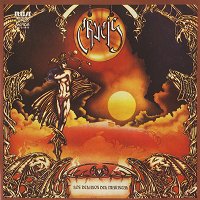 With their second album, Crucis became probably the best produced band from the Argentinean progressive rock scene of the '70s. The record boasts a powerful and crystal clear sound, and the band's style had changed slightly to a more polished, jazzier, symphonic and surprisingly Dutch-sounding style of progressive rock. The songs were longer than on on the debut, and guitarist Pino Marrone shows clear influences from Jan Akkerman, Mario Millo and Andy Latimer here. There's also a much more instrumental focus, as the opener "No Me Separan de Mi" is the only song on the record with vocals. And it's a truly stunning opening, featuring an instantly memorable vocal melody that makes the core for the instrumental section at the end, where the constant repetition of the theme never really feels repetitive, but powerful and striking. The title-track is a lush, symphonic, airy and atmospheric journey where Marrone delivers some beautiful melodic themes which remind me slightly of Sebastian Hardie. The pace and intensity shifts toward the end of the track, where a much more upbeat and joyful part appears, stuffed with catchy synth-melodies from keyboardist Anibal Kerpel. "Pollo Fritto" brings the band over into jazzier territory, boasting impressive dynamics and beefy riffs along with the complexity that pervaded more or less all of Crucis' material. "Abismo Terrenal" is the definitive showcase for the band's instrumental skills, as well as being based around one of their best themes. The lengthy solos, especially from Marrone, are thoroughly impressive in all their intensity and technical brilliance. So in conclusion, "Los Delirios del Mariscal" is one of the essential ones from the Argentinean '70s progressive rock scene. With their second album, Crucis became probably the best produced band from the Argentinean progressive rock scene of the '70s. The record boasts a powerful and crystal clear sound, and the band's style had changed slightly to a more polished, jazzier, symphonic and surprisingly Dutch-sounding style of progressive rock. The songs were longer than on on the debut, and guitarist Pino Marrone shows clear influences from Jan Akkerman, Mario Millo and Andy Latimer here. There's also a much more instrumental focus, as the opener "No Me Separan de Mi" is the only song on the record with vocals. And it's a truly stunning opening, featuring an instantly memorable vocal melody that makes the core for the instrumental section at the end, where the constant repetition of the theme never really feels repetitive, but powerful and striking. The title-track is a lush, symphonic, airy and atmospheric journey where Marrone delivers some beautiful melodic themes which remind me slightly of Sebastian Hardie. The pace and intensity shifts toward the end of the track, where a much more upbeat and joyful part appears, stuffed with catchy synth-melodies from keyboardist Anibal Kerpel. "Pollo Fritto" brings the band over into jazzier territory, boasting impressive dynamics and beefy riffs along with the complexity that pervaded more or less all of Crucis' material. "Abismo Terrenal" is the definitive showcase for the band's instrumental skills, as well as being based around one of their best themes. The lengthy solos, especially from Marrone, are thoroughly impressive in all their intensity and technical brilliance. So in conclusion, "Los Delirios del Mariscal" is one of the essential ones from the Argentinean '70s progressive rock scene.
Curved Air - "Air Conditioning" (Warner Brothers 1970)
 The first progressive rock band with a female singer that I got into, so I guess it was about time that I write some reviews for them! Fronted by the excellent female-vocals of Sonja Kristina and the classical influenced violin playing by Darryl Way, Curved Air sounded like no other progressive band. This was their debut-album and it's also a historical album because it was history's first LP-sized picture disc! Musically it was also a successful debut stuffed with good material and the classic Curved Air sound. Even their bastardization of Vivaldi makes some quite entertaining listening. The opening track "It Happened Today" shows many sides of Curved Air's music. A rocking and catchy vocal-part that gets relieved by a beautiful and atmospheric violin part. The instrumental "Rob One" is another fine example of Way's excellent and emotional playing. Other great tracks include the sinister "Screw", the light and nice acoustic piece "Blind Man", the dark "Situations" and "Hide and Seek". You also get a non-progressive but excellent rock track in "Stretch". Overall a very good debut-album, but even better things was still to come! The first progressive rock band with a female singer that I got into, so I guess it was about time that I write some reviews for them! Fronted by the excellent female-vocals of Sonja Kristina and the classical influenced violin playing by Darryl Way, Curved Air sounded like no other progressive band. This was their debut-album and it's also a historical album because it was history's first LP-sized picture disc! Musically it was also a successful debut stuffed with good material and the classic Curved Air sound. Even their bastardization of Vivaldi makes some quite entertaining listening. The opening track "It Happened Today" shows many sides of Curved Air's music. A rocking and catchy vocal-part that gets relieved by a beautiful and atmospheric violin part. The instrumental "Rob One" is another fine example of Way's excellent and emotional playing. Other great tracks include the sinister "Screw", the light and nice acoustic piece "Blind Man", the dark "Situations" and "Hide and Seek". You also get a non-progressive but excellent rock track in "Stretch". Overall a very good debut-album, but even better things was still to come!
Curved Air - "Second Album" (Warner Brothers 1971)
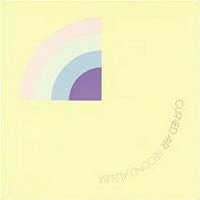 The second album was even better than the debut but it also demonstrated the tensions between the two songwriters in the band, Darryl Way and keyboard-player Francis Monkman. All of Way's compositions were on side one of the album, while Monkman's was on the second side. Way's side of the album is completely flawless and the band had also begun to use moog to great effect on the superb opening-track "Young Mother". "Puppets" is a mellotron-drenched and atmospheric beauty while "Back Street Luv" became the band's biggest hit when it was released as a single. Monkman's side featured two great tracks with "Everdance" and the 12-minute dark and gloomy "Piece of Mind". "Bright Summer's Day '68" is on the other hand a track that doesn't do much for me, and stands as the only weak track on the album. Anyway, great album! The second album was even better than the debut but it also demonstrated the tensions between the two songwriters in the band, Darryl Way and keyboard-player Francis Monkman. All of Way's compositions were on side one of the album, while Monkman's was on the second side. Way's side of the album is completely flawless and the band had also begun to use moog to great effect on the superb opening-track "Young Mother". "Puppets" is a mellotron-drenched and atmospheric beauty while "Back Street Luv" became the band's biggest hit when it was released as a single. Monkman's side featured two great tracks with "Everdance" and the 12-minute dark and gloomy "Piece of Mind". "Bright Summer's Day '68" is on the other hand a track that doesn't do much for me, and stands as the only weak track on the album. Anyway, great album!
Curved Air - "Phantasmagoria" (Warner Brothers 1972)
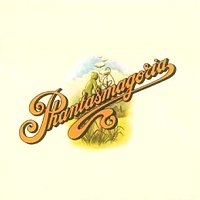 The third album is more diverse; experimental but also less accessible than the two first albums, and many people claims this to be Curved Air's best album. The track "Over and Above" reminds me a lot of "Octopus"- styled Gentle Giant. Both this track and the calypso (??)-influenced "Once a Ghost Always a Ghost" featured vibes and xylophone and gave the band a slightly more jazzy sound. "Whose Shoulder are You Looking Over Anyway" could almost be called electronic music with Kristina's voice electronically distorted in any way possible. The rest of the album is more in the classic and typical Curved Air vein. Both the title-track and "Maria Antoinette" (a song about the French revolution) are excellent melodic progressive rock pieces with the typical integrated classical influence of the band. The acoustic, folky and baroque "Melinda (More or Less)" is three minutes of the purest beauty, while "Not Quite the Same" (a song about masturbation!) showed the less serious side of Curved Air. And "Cheetah" is a instrumental where Way demonstrated his skills on the violin. Excellent and unique stuff. The third album is more diverse; experimental but also less accessible than the two first albums, and many people claims this to be Curved Air's best album. The track "Over and Above" reminds me a lot of "Octopus"- styled Gentle Giant. Both this track and the calypso (??)-influenced "Once a Ghost Always a Ghost" featured vibes and xylophone and gave the band a slightly more jazzy sound. "Whose Shoulder are You Looking Over Anyway" could almost be called electronic music with Kristina's voice electronically distorted in any way possible. The rest of the album is more in the classic and typical Curved Air vein. Both the title-track and "Maria Antoinette" (a song about the French revolution) are excellent melodic progressive rock pieces with the typical integrated classical influence of the band. The acoustic, folky and baroque "Melinda (More or Less)" is three minutes of the purest beauty, while "Not Quite the Same" (a song about masturbation!) showed the less serious side of Curved Air. And "Cheetah" is a instrumental where Way demonstrated his skills on the violin. Excellent and unique stuff.

|